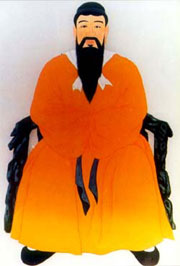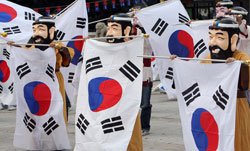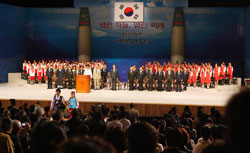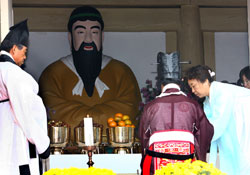
Dangun Wanggeom, founder of first Korean nation in 2333 B.C.
It's happy birthday to Korea! This year Korea celebrates its 4,341st anniversary of founding, dating back to 2333 B.C.
The Korean term for national foundation day is “Gaecheon-jeol” meaning “the Opening of Sky/Heaven.” Such a title is derived from the legend of Dangun Wanggeom, popularly known as the founder of “Gojoseon” (2333–108 B.C.), the first kingdom of Korea.
Dangun's story begins with his father, Hwanung, the son of heaven, who opened up the sky to descend to earth with 3,000 followers, including the god of wind, rain and cloud. Hwanung ruled the land peacefully and the land prospered under his leadership.
One day a tiger and a bear came before Hwanung, begging to become human. Hwanung gave them sacred garlic and onions and asked them to eat only these and stay away from sunlight for 100 days. The two hid themselves inside a cave.
It was the tiger who gave up first, less then a month later, and the bear who persevered to the end. After the promised 100 days the bear found herself changed into a beautiful woman. She was called “Ungnyeo” meaning “bear woman” but was not accepted by villagers due to her past as an animal. Hwanung took pity on her, made her his wife and she bore a son who was Dangun Wanggeom, founder of Korea.
The story has been passed down consistently through historical records and various religious rituals of the kingdom of Buyeo (239 B.C.–A.D. 494), the confederacy of Mahan (1st century B.C.–A.D. 3rd century), Goguryeo (37 B.C.-A.D. 668), Baekje (18 B.C.–A.D. 660), Silla (57 B.C.–A.D. 935) and the subsequent two dynasties Goryeo (918-1392) and Joseon (1392-1910).
It was Na Chol (1863-1916), the founder of Daejonggyo, who tried to keep up the tradition. Daejonggyo is a national religion that worships Dangun and his progenitors. It was his idea to designate Oct. 3 (by the lunar calendar) as foundation day in 1909. The date was based on the record of the Comprehensive Mirror of the Eastern Kingdom (Dongguk Tonggam) written in 1458.
During Japan's annexation of Korea (1910-1945), the Korean provisional government in Shanghai honored the day together with the members of Daejonggyo. After national liberation, the Republic of Korea in 1949 decided to lock in the date Oct. 3 as foundation day, instead of moving it around every year according to the lunar calendar.
Grand opening of Hongik Historic Cultural Park

Mt. Baekdusan where legendary Hwanung descended from heaven (Photo: Yonhap News)
Returning to the celebration of Korea's 4,341st birthday, there's going to be the grand opening of the Han People Historic and Cultural Park at Mt. Heukseongsan in Cheonan-si, Chungcheongnam-do (South Chungcheong Province) on Oct. 3.
The opening ceremony will be presided over by Kookhakwon, a private research institute dedicated to the study of Dangun and the founding philosophy of Korea, and sponsored by the Ministry of Culture, Sports and Tourism, the World Earth Human Alliance, and the World Korean Association among other top organizations.
A pre-opening ceremony that begins at 1:30 will feature gilnori (road play) and a dance by the World Kookhakwon Youth Association.
The full ceremony will begin at 2 p.m. with Chun-go (initiation of heaven) video clips, a drum dance, introduction of guests, a report on the progress of the park so far, a flag ceremony, Arirang song and a chorus of Shin-segye (the New World).
The second part will celebrate the second World Earth Human Festival, with welcoming performances from Korea, Japan, the United States and Canada. The occasion will be celebrated with over 10,000 visitors, including some 1,000 congratulatory delegates from eight nations including the United States, Canada and Germany.
“The festival is prepared to further promote the Korean philosophy of Hongik to the world,” an official at Kookhakwon explained. A national spirit photo exhibition, a flying wind lamp, and a Dangun costume play are also prepared for the function.

Kookhakwon's Dangun parade at Jongno street prior to the official ceremony on Oct. 3. (Photo: Yonhap News)
The park, which is being prepared on nearly 20,000 square meters is to provide a learning space for Korea's time-honored philosophy of “Hongik” (benefitting all humans) handed down from coming from Gojoseon times.
It will also have an exhibition hall with statues of Dangun and other historical figures of the country, an education facility for history and cultural studies, and a hall commemorating national liberation and other themes. The first stage of the park has been completed with donations from Kookhakwon and Koreans from both home and abroad.
The second and third stage of the park, to be set up from 2010 to 2012, will have an experience village and archery rooms and a hall for folk arts, among others.
More celebrations await

Government celebration of National Foundation Day (Gaecheonjeol) (Photo: Yonhap News)
Back in Seoul, the Ministry of Public Administration and Security will hold a grand ceremony to celebrate the national foundation day at the Sejong Arts Center, downtown Seoul.
Government officials from various sectors, foreign representatives based in Korea, volunteer workers, students and some 3,000 people will join in the event to hail the special day.
The processions will include an introduction to the national foundation, performances, a congratulatory speech from the prime minister, the song of Gaecheon-jeol, and three cheers of “long live Korea.”
The “Gaecheon Daejae ritual” will take place on the same day at Dangun Shrine in Jongno-gu, Seoul. The present Dangun Shrine was built in 1962, and put under the exclusive management of Seoul Metropolitan Office in 1969. Gaecheon Daejae, referring to the ceremony for national foundation, has been taking place every Oct. 3rd for over the past 40 years ever since.

Gaecheon Daejae Ritual (Photo: Yonhap News)
This year's ceremony begins with the lecture on Dangun and globalization, followed by a presentation of traditional liquor, expressing thanks to ancestors and sharing the foods prepared. A Samulnori (a percussion quartet) performance and a demonstration of the Korean traditional martial art takkyeon will follow.
A similar ritual will take place at Mt. Manisan in Ganghwa-do (Ganghwa Island) together with a local art festival there. During this day access to the National Science Museum based in both Seoul and Daejeon will be free of charge.
Meanwhile Taegukgi (Korean national) flags have already been flying high in the major streets and roads in Seoul and other parts of the nation since the beginning of October.
By Kim Hee-sung
Korea.net Staff Writer